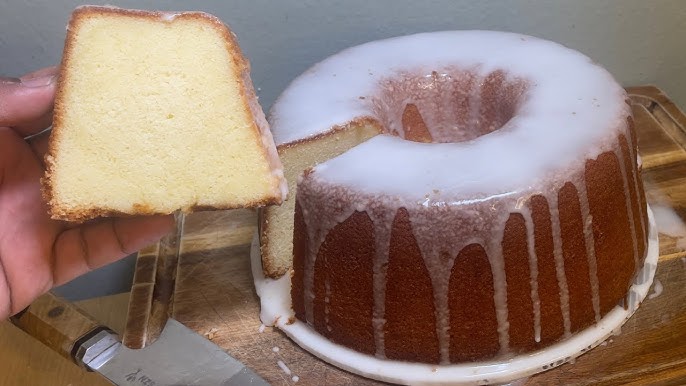7up Cake Recipe: A 7UP cake is a Southern classic that blends the zing of lemon-lime soda with the richness of a pound cake. You read that right—7UP, the popular citrus soda, is a key ingredient in this beloved dessert. What makes this cake stand out is its moist texture, dense crumb, and subtle citrusy aroma, all without using any baking soda or baking powder. The carbonation in the soda takes care of the rising process while adding an unexpected but delicious flavor twist.
The base of this recipe follows the traditional pound cake formula, but the magic lies in the 7UP. With each bite, you’ll experience a perfect balance of sweet and zesty. It’s a cake that’s simple to make but impressive enough to wow at potlucks, family dinners, and holidays. Whether glazed or left plain, this cake delivers on all fronts: flavor, texture, and nostalgia.
History and Popularity
The 7UP cake first started appearing in kitchens around the 1950s and 1960s, during the height of the soda-pop era. Home bakers began experimenting with soft drinks like Coca-Cola, Sprite, and 7UP to enhance the flavor and fluffiness of cakes. This innovation brought about the iconic 7UP pound cake, which soon gained a permanent spot in Southern dessert traditions.
It became especially popular because of its simplicity—no need for baking powder or soda, as 7UP’s fizz does the job. Over the decades, it’s become a go-to recipe for those who want a cake that’s both homey and different. You’ll often see it on Sunday dinner tables, at church gatherings, and even during the holidays.
Ingredients Needed
For the Cake Batter
Here’s what you’ll need to create this citrus-infused masterpiece:
- 3 sticks (1½ cups) of unsalted butter, softened
- 3 cups of granulated sugar
- 5 large eggs
- 3 cups of all-purpose flour
- 2 teaspoons of pure lemon extract
- ¾ cup of 7UP (not diet)
These basic pantry staples come together to form a batter that’s rich, creamy, and laced with lemon-lime flavor. Be sure to use room-temperature butter and eggs for the best texture.
For the Glaze (Optional)
The glaze isn’t mandatory, but it definitely elevates the final product. Here’s what you’ll need:
- 1 cup of powdered sugar
- 2 tablespoons of fresh lemon juice
- 1 tablespoon of 7UP
Mix these for a sweet, tangy glaze that gives the cake a nice finish and added moisture.
Kitchen Tools Required
To bake a perfect 7UP cake, make sure you have the following kitchen essentials:
- Stand or hand mixer
- Large mixing bowls
- Measuring cups and spoons
- Bundt pan or tube pan
- Rubber spatula
- Wire cooling rack
- Whisk (for glaze)
- Toothpick or cake tester
Having the right tools ensures even mixing and baking, which is critical for a dense yet soft cake like this one.
Preparing the Batter
Step-by-Step Instructions
- Cream the butter and sugar: In a large mixing bowl, beat the butter and sugar together until light and fluffy. This may take up to 5–7 minutes with a stand mixer on medium speed. Don’t rush this part—it sets the foundation for a great texture.
- Add eggs one at a time: Crack in the eggs one by one, mixing well after each addition. This ensures that the batter remains smooth and emulsified.
- Incorporate flour gradually: With the mixer on low, add the flour one cup at a time. Scrape down the sides of the bowl to make sure everything’s incorporated.
- Add flavoring and soda: Stir in the lemon extract and slowly pour in the 7UP. The batter will become slightly airy as the carbonation reacts with the other ingredients.
- Mix until just combined: Do not overmix after adding the soda. You want to keep the air bubbles intact for that light texture.
Mixing Tips and Tricks
- Always sift your flour before adding it to the batter.
- Use a rubber spatula to gently fold in the final ingredients.
- Avoid overbeating once the 7UP is added to maintain the cake’s fluffiness.
Baking the Cake
Temperature and Timing
Preheat your oven to 325°F (163°C). Grease and flour your bundt or tube pan generously to avoid sticking. Pour the batter in and smooth the top with a spatula.
Bake for 70 to 80 minutes, or until a toothpick inserted in the center comes out clean. The top should be golden brown and the edges should start pulling away from the pan slightly.
How to Check Doneness
Don’t rely only on timing. Use the following methods:
- Insert a toothpick or cake tester in the thickest part of the cake—it should come out clean or with a few crumbs.
- Lightly press the top of the cake; if it springs back, it’s ready.
- Look for golden brown color and a slight cracking on the surface.
Cooling and Glazing the Cake
Cooling Tips
Once your cake is fully baked, resist the urge to remove it from the pan immediately. Let it cool in the pan on a wire rack for at least 20 minutes. This short waiting period helps the cake firm up slightly, reducing the chances of breaking or crumbling when removed.
After 20 minutes, gently loosen the edges using a butter knife. Then, invert the cake onto a wire rack or serving plate. Allow it to cool completely—this can take about 1–2 hours depending on your kitchen temperature. A completely cooled cake holds its shape better and absorbs glaze more evenly if you plan to use one.
Pro Tip: Avoid placing a hot cake directly on a cold surface. Sudden temperature changes can cause cracks.
Making the Glaze
If you’re looking for that extra pop of sweetness and shine, a simple glaze works wonders.
Here’s how to make it:
- Whisk together the powdered sugar, lemon juice, and 7UP in a small bowl until smooth.
- Adjust consistency by adding more sugar to thicken or a few drops of lemon juice to thin it out.
- Drizzle it over the completely cooled cake using a spoon or pour it in zigzag motions for a decorative look.
This glaze hardens as it sits, forming a thin, sweet shell on the cake. It’s tart, tangy, and perfectly balances the cake’s richness.
Serving Suggestions
The 7UP cake is a showstopper all on its own, but serving it creatively can elevate the experience.
Here are a few ideas:
- Serve warm with a scoop of vanilla ice cream for a contrast of temperatures.
- Pair with fresh berries like strawberries or blueberries to add freshness and color.
- Add whipped cream and a lemon twist for a more elegant dessert presentation.
- Serve with coffee or tea during brunch or afternoon tea.
This cake holds up well in any setting—from casual family gatherings to formal dinners. Its subtle citrus flavor makes it a year-round favorite.
Variations of 7UP Cake
Want to get creative with your 7UP cake? You absolutely can! Here are two mouthwatering twists on the classic:
Lemon 7UP Cake
Love lemon? Intensify the citrus notes with these changes:
- Use lemon zest and fresh lemon juice in place of lemon extract.
- Add a lemon glaze made with lemon juice and powdered sugar.
- Top with candied lemon slices for a beautiful finish.
This version is extra zesty and perfect for lemon lovers.
Coconut 7UP Cake
For a tropical twist:
- Add ½ cup of shredded coconut to the batter.
- Substitute lemon extract with coconut extract.
- Top with coconut glaze and toasted coconut flakes.
This adds a new texture and a tropical flair, making it perfect for summer.
These variations are just the start. Once you master the basic 7UP cake, the possibilities are endless!
Storage and Shelf Life
One of the best things about a 7UP cake? It stays moist for days!
Here’s how to store it properly:
- At room temperature: Keep the cake covered in an airtight container or under a cake dome. It’ll stay fresh for up to 4 days.
- In the fridge: Wrap it tightly in plastic wrap or foil. It can last for up to a week.
- Freezing: Wrap individual slices or the whole cake in plastic wrap, then aluminum foil. Store in a freezer-safe bag for up to 3 months. Thaw overnight in the fridge before serving.
Tip: Avoid refrigerating an unwrapped cake—it can dry out quickly.
Common Mistakes to Avoid
Even a simple recipe like this can go sideways if you’re not careful. Here are some pitfalls to dodge:
- Using cold ingredients: Cold butter or eggs can cause the batter to curdle or not mix properly. Always use room-temperature ingredients.
- Overmixing: Once you add the 7UP, go easy on the mixing. Overmixing can deflate the carbonation and lead to a dense cake.
- Not greasing the pan well: Bundt cakes are notorious for sticking. Use a generous amount of butter or non-stick spray and flour every inch.
- Skipping the cooling step: Removing the cake too soon from the pan can cause it to collapse or stick.
- Using diet soda: Don’t! It won’t react the same way and could throw off the flavor and texture.
Being mindful of these common mistakes ensures your 7UP cake turns out bakery-perfect every time.
Nutritional Information
Wondering what’s really in that delicious slice of 7UP cake? Here’s a general breakdown for one slice (based on a 12-slice serving):
| Nutrient | Amount |
|---|---|
| Calories | ~420 kcal |
| Total Fat | 20g |
| Saturated Fat | 12g |
| Cholesterol | 110mg |
| Sodium | 180mg |
| Total Carbohydrates | 55g |
| Sugars | 38g |
| Protein | 4g |
Note: These values may vary based on ingredient brands and portion sizes.
This cake is definitely a treat—rich in butter and sugar—so enjoy it in moderation. However, it’s worth every bite when shared with friends or served on a special occasion. You can slightly reduce sugar or substitute healthier ingredients if you’re looking to cut calories, but keep in mind that the texture and flavor may change.
FAQs about 7up Cake Recipe
Can I use diet 7UP in this recipe?
It’s not recommended. Diet sodas lack the same sugar content and carbonation strength as regular 7UP, which can affect both the flavor and the rise of your cake.
Can I freeze 7UP cake?
Absolutely! Let the cake cool completely, wrap it in plastic wrap and foil, and freeze it for up to 3 months. Thaw it overnight in the fridge before serving.
Why is there no baking powder or baking soda in the recipe?
The carbonation in 7UP acts as a leavening agent, helping the cake rise without the need for additional baking powder or soda.
Can I use a different soda instead of 7UP?
Yes, you can experiment with other citrus sodas like Sprite or Mountain Dew, but each will slightly alter the taste and texture.
How long can 7UP cake sit out?
It can safely sit out at room temperature for up to 4 days when properly covered or stored in an airtight container.
Conclusion
The 7UP cake isn’t just a recipe—it’s a slice of nostalgia baked into a beautiful, golden bundt. With its rich, buttery flavor and citrus undertone, this cake has stood the test of time for a reason. It’s simple enough for beginners but elegant enough for special occasions. Whether you enjoy it plain, with a tangy glaze, or dressed up with toppings, it’s a dessert that brings warmth to any gathering.
Plus, the fact that it doesn’t require baking powder or soda? That’s just culinary magic, courtesy of a fizzy soda we all know and love. So go ahead—gather your ingredients, preheat that oven, and bake up a little joy. Once you try it, you’ll understand why it’s a Southern classic and a family favorite.



